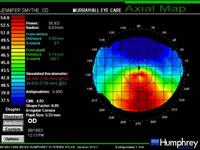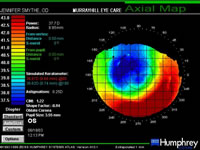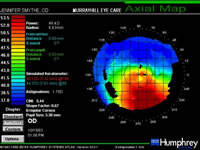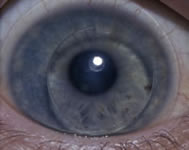The benefits of silicone hydrogel contact lenses for the normal
cornea have been well established. Most notably, complications
related to hypoxia have been virtually eliminated. The physiological
response (or lack thereof) has paved the way for more advanced
applications of these high-Dk materials. This includes utilization
of the lenses for therapeutic benefit. Silicone hydrogel lenses
have quickly become a welcome breakthrough in the specialty contact
lens practice.
Until recently an underutilized modality of contact lens correction
was the "piggy-back" fit. With current material and
design advancements, this system of a rigid contact lens worn
over a soft lens on same eye is a viable option for problem solving
lens decentration, maintaining corneal epithelial integrity and,
enhancing patient comfort.
A fifty-four year old healthy woman (NU) was referred to the
office by a local refractive surgeon for a contact lens fitting
OD. NU had Lasik OU in December 1998 and two enhancements OD
in 3/99 and 6/00. This very active patient reported that she
was happy with her vision in the left eye however, she was constantly
aware of blur OD, especially during her daily golf game. Prior
to having Lasik, NU wore rigid contact lenses for thirty years
which, she discontinued one month before surgery. She reported
hypersensitivity to Benadryl otherwise, her medical history was
unremarkable. Uncorrected visual acuity was 20/200 OD, 20/20-1
OS and some improvement was achieved with the following manifest
refraction:
OD -1.75-1.75 X 080 20/40-2
OS -0.50 -0.25 X 088 20/20
Videokeratoscopy was performed and the corneal map displayed
significant inferior ectasia OD and a fairly normal and well
centered ablation zone OS (Figures 1 and 2).
 |
 |
| Figure 1: OD, Post Lasik and
2 enhancements - click to enlarge |
Figure 2: OS, Post-Lasik - click
to enlarge |
Further inspection
of the topography OD revealed over a 20D difference between
the apex (steepest point inferiorly) and the superior mid-peripheral
cornea. Several GP corneal designs with various optic zone
diameters and base curves were diagnostically trialed however,
every attempt to either clear or limit the amount of bearing
on the inferior cornea caused excessive impingement of the contact
lens on the superior cornea. Subsequently each lens decentered
significantly inferiorly. Diagnostic fitting with GP scleral
lenses (both fenestrated and non-fenestrated designs) also failed
due to bubble entrapment secondary to the severe disparity between
the superior and inferior corneal curvature. The decision was
finally made to attempt a piggy-back fitting.
 |
 |
| Figure 3: OD, Over 8.6/+0.75 FND - click
to enlarge |
Figure 4: Piggy Back System - click
to enlarge |
A Focus Night and Day (Ciba Vision) 8.6 / 13.8 +0.75 D was
inserted and video-keratoscopy was performed over the top of
the silicone hydrogel contact lens (Figure 3). The base curve
of an appropriate GP lens was selected based on the radius of
curvature 3 mm temporal from center on the corneal map. A 43.00
D / 9.5 / -3.00 CAD (Valley Contax) GP lens was placed on top
of the silicone hydrogel. The lens positioned slightly low and
a bubble was trapped between the two contact lenses in the mid-periphery
which could potentially encroach upon into the papillary zone
in dim illumination. A smaller OAD/OZ diameter lens in the same
base curve and design was then trialed and it centered well without
any bubble entrapment (Figure 4). The Nafl pattern displayed
slight apical touch of the rigid lens and no edge fluting of
the soft contact lens. Both lenses moved freely with the blink
without excessive decentration, the patient reported that comfort
was excellent and through a spherical over-refraction visual
acuity was 20/25.
NU has been successfully wearing Focus Night and Day 8.6 /
138 / +0.75 with a CAD HDS 100 43.00 D / 9.0 / -4.00 OD for over
5-months and performs nightly disinfection and storage in AoSept
ClearCare (Ciba Vision). Acuity with the lenses has been a stable
20/25+1 and she is thrilled with the comfort and clarity of vision
that the system provides. She was re-evaluated at one week, one-month
and three months post-dispense and no physiological compromise
has been observed.
There are a multitude of indications for the piggy-back technique
for both the regular and irregular cornea. Although the most
common condition that may warrant a piggyback modality is keratoconus,
as observed in the case of NU, post-surgical ectasia can mimic
the corneal topography of this degeneration. As the asymmetry
between the superior and inferior cornea increases, maintaining
centration and limiting impingement or bubble entrapment of a
rigid contact lens is often a significant challenge. A piggyback
system worn full-time, or even for part of the day, can increase
maximum wear time of the rigid contact lens and ultimately have
a positive impact on the patient's quality of life.
|